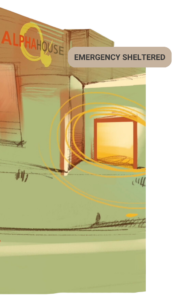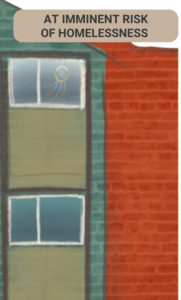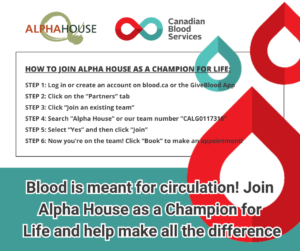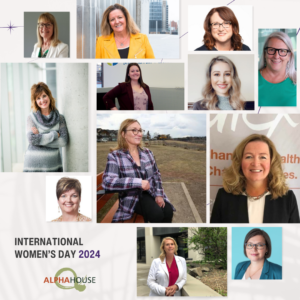World Homeless Day
Shaundra Bruvall | October 9, 2024
Talking about the Continuum of Homelessness

Today, October 10th, marks World Homelessness Day. Along side many other agencies in the Calgary community, Alpha House works with individuals who are experiencing homelessness or at risk of homelessness. At Alpha House, we hear many misconceptions from community members about homelessness – that all experiences of homelessness are alike or that people become homeless because of bad financial decisions or personal choices. It is easy to make assumptions about people experiencing homelessness but the reality of people’s experiences is often far more complex. We talk about homelessness as a spectrum of situations that people can move through because it helps contextualize the vast array of experiences people have with being unhoused.
We’ll talk about: Unsheltered, Emergency Sheltered, Provisionally Accommodated, and At Imminent Risk of Homelessness

Unsheltered refers to the individuals who are sleeping in places not meant for human habitation; often referred to as “rough sleepers” or “campers”. Rough sleepers often won’t access shelter resources and services regardless of external factors. This means even in inclement weather scenarios (where it’s minus 30 or plus 30) individuals will remain outside. There are any number of reasons why someone chooses not to access a Shelter. Sometimes past traumas can make it difficult for someone to stay in an enclosed space with other people. People with pets will often stay outside because Shelters can’t accommodate animals, and couples will sometimes stay outside rather than accessing shelter services and risk being separated. Something we tend to take for granted is personal and private spaces. Shelters were created as a temporary response to crisis situations; they were not built for comfort or privacy. Being in a shared environment, sleeping next to a hundred other individuals often isn’t the most comfortable situation. While encampments may be a more comfortable option for people, they often signify a difficult compromise that ultimately points to a lack of adequate housing more so than it points to issues with shelters.

Emergency Sheltered is a category that includes Emergency Shelters such as Alpha House, The Drop-In Centre, and The Mustard Seed, accessed by individuals experiencing homelessness who are seeking services. This can include meals, donated clothing, showers and basic hygiene supplies, or medical assessments and treatment. Alpha House’s Shelter hovers around 90% capacity year-round, usually reaching capacity during extreme weather conditions such as heat waves or cold snaps. In 2022, according to The Calgary Homeless Foundation, 40% of Calgary’s homeless population were located in emergency shelters. [1]

Provisionally Accommodated This would include hospitals, correctional facilities and transitional housing. These individuals technically have accommodations but, at some point, they will either be discharged or their terms will end leading them to the streets. Programs that include temporary accommodations are not at fault for not housing people anymore than Shelters; none of the measures in place to help people who are experiencing homelessness are long-term replacements for the need for adequate housing.

Individuals categorized as at Imminent Risk of Homelessness are those currently housed but at high risk of losing their housing. Individuals could be in this category for a variety of reasons: spending majority of their income on rent due to increasing housing costs, sudden unemployment, rising cost of living, family violence, etc.
Alpha House aims to reduce barriers by providing services along a continuum of care, facilitating the transition to stable housing for individuals at different stages of homelessness. For those who are unsheltered, Alpha House’s Encampment Team exists to actively support ‘rough sleepers’ with connections to appropriate shelter services and housing options where possible, while providing basic needs supplies and other referrals. For those accessing Emergency Shelter, Alpha House’s Shelter serves individuals in crisis needing a safe place to sleep and provides access to showers, medical assistance, and warm meals. Alpha House’s Shelter is specifically for individuals under the influence of substances.
Our housing programs encompass two key streams: Permanent-Supportive Housing, which offers 24/7 wrap around supports for those needing daily assistance, and Community Housing, where individuals live independently but have bi-weekly support through their caseworkers to increase capacity with everyday skills.
Alpha House’s Diversion program proactively assists individuals at imminent risk of homelessness, helping them maintain their housing and avoid crises. Research indicates that once someone experiences homelessness, the barriers to regaining stable housing significantly increase. The Diversion program aims to provide the financial and logistical support necessary for those who can live independently but require an initial boost to get back on their feet.
As we observe World Homelessness Day, it’s crucial to remember that homelessness is not a one-size-fits-all issue. The diverse experiences of those affected highlight the importance of understanding and compassion in our approach to this complex social challenge. Each individual’s story is unique, shaped by a variety of circumstances often outside of that person’s control. By recognizing the Continuum of Homelessness and the various challenges people face, we can foster greater empathy and awareness within our communities and ultimately build better solutions.
View our World Homeless Day video on our YouTube Channel here
[1] https://www.calgaryhomeless.com/wp-content/uploads/2024/04/CHF-PiT-Count-Report2022.pdf




